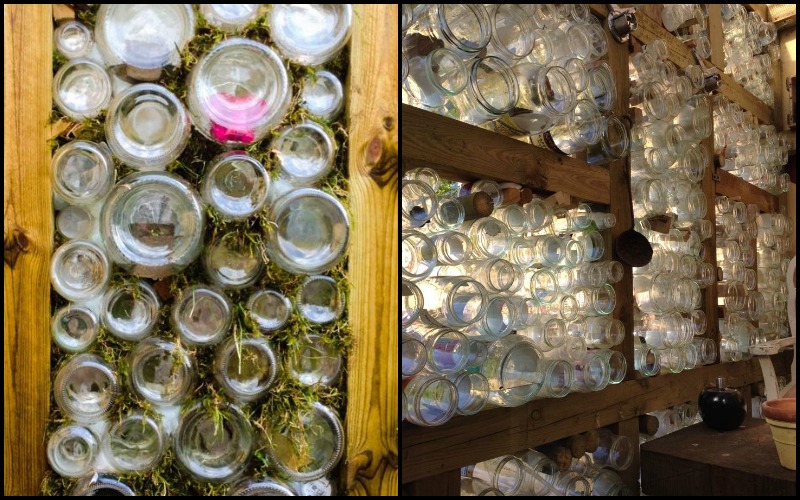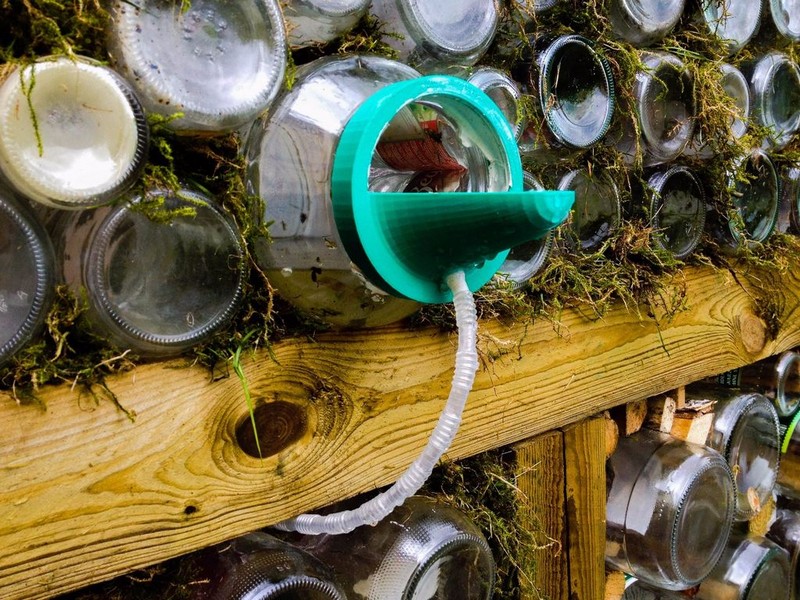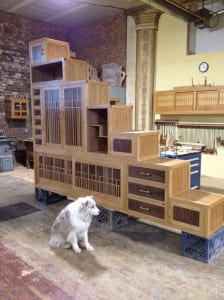Last Updated on March 14, 2024 by teamobn
Want to build a greenhouse in your backyard? If you have access to plenty of glass jars, you can use them for a very cheap glass jar greenhouse project!

Start asking your friends and neighbors for empty jam jars. You can also ask your local restaurants and takeaways to keep bottles for you! This greenhouse costs almost nothing depending on the materials you already have. We’ve been collecting glass jars for quite some time now without any purpose in mind. When we came across this idea we’re glad we’re already halfway through getting enough glass jars for this greenhouse project!
This is a great idea since you can even use the largest glass jars to start some seeds — mini greenhouses inside a greenhouse!
The only thing missing in this greenhouse is the permanent roof. If you were to build one, what roofing will you use?
Read on to see how DIY-er dklafe built his glass jar greenhouse and share your ideas on how it can be further improved!
Would you like to build your own version of a glass jar greenhouse? 🙂
Contents
Building a Glass Jar Greenhouse
Materials
- 10 x 10cm Fence Posts
- Glass Jars with Lids
- Moss
- Cement
- Fine Gravel
- Wheelbarrow
- Door Hinges and Handle
- Screen
Tools
- Shovel
- Measuring Tape
- Drill
Instructions

I used 10cm x 10cm “fence” posts for the frame which worked out quite nicely with the average height of my glass jars.
My greenhouse is “free standing” but I guess it would be best to have some sort of foundation if building on grass – the final structure is quite heavy.

It is important not to make the spaces between the posts – too large, stacking the glasses can be tricky – and if they are high up can be dangerous.


My greenhouse is roughly 2m square – and when it’s finished will probably have used about 1000 jam jars. (and i have only filled 3 out of 4 walls). I asked all my neighbors and colleagues to bring me their jars. The canteen at work was also great for getting oversized jars – the big jars can have multiple uses.

I 3D printed this adapter to collect rain water. The files are available from thingiverse.

I mixed some fine gravel and a bag of cement (no water) – I spread the mixture on the floor about 1cm deep. I then pressed in the lids, trying not to think about the order and colours. I like the random look.

After a few days the gravel/cement mixture had absorbed moisture from the air and had set.
TIP: I was amazed at how many lids were required to tile the floor. You might want to ensure you have enough lids before setting them in cement.
Thanks to dklafe for this great idea!
Benefits of Using Glass Jars in Greenhouses
Building a glass jar greenhouse offers a unique, sustainable way to cultivate plants while repurposing materials that might otherwise end up in landfills. This approach to constructing greenhouses reflects a commitment to environmental stewardship and harnesses the distinctive advantages of glass as a material for nurturing plant life.
Below, we explore the myriad benefits of using glass jars in greenhouses, highlighting how this innovative method can transform your gardening experience.
Sustainable and Eco-friendly
One of the foremost benefits of a glass jar greenhouse is its sustainability. By repurposing glass jars, gardeners reduce waste and contribute to a circular economy. Glass is a highly available material that has a long lifespan and will not rust or degrade like other materials.
Optimal Light Diffusion
Glass jars are excellent at diffusing light, ensuring that plants within the greenhouse receive a uniform distribution of sunlight. This diffusion helps mitigate plant burn risk and promotes even growth across all plants housed within the glass jar greenhouse. The translucency of glass also ensures that a maximum amount of natural light reaches the plants, crucial for photosynthesis and healthy development.
Insulation and Temperature Regulation
Glass jars offer superior insulation properties. In a glass jar greenhouse, the air trapped between the jars acts as an insulating layer, helping to maintain a consistent internal temperature. This natural temperature regulation benefits plant growth, extending the growing season and protecting delicate seedlings from external weather fluctuations.
Aesthetic Appeal
A glass jar greenhouse is not only functional but also visually striking. The unique aesthetic of glass jars arranged in intricate patterns creates a stunning visual display that enhances the beauty of any garden. This greenhouse becomes a focal point, blending functionality with artistic expression.
Durability and Longevity
Glass is a durable material resistant to many forms of degradation, including rust, rot, and UV damage. A greenhouse made from glass jars can withstand harsh weather conditions, from scorching sun to heavy snow, ensuring longevity and reducing the need for frequent repairs or replacements.
Cost-effective Construction
For those looking to build a greenhouse on a budget, glass jars offer a cost-effective solution. Many people have access to glass jars through recycling or can collect them at little to no cost from community sources. This makes the construction of a glass jar greenhouse highly affordable, especially compared to traditional greenhouse materials.
Incorporating glass jars into greenhouse construction promotes environmental sustainability and offers practical benefits for gardeners. A glass jar greenhouse provides optimal conditions for plant growth, combining functionality with environmental responsibility in a visually appealing structure. This innovative approach to gardening invites us to reconsider the materials we use and their impact on the planet, offering a model for sustainable living that is both practical and inspiring.
Design Considerations and Planning
Designing a glass jar greenhouse involves carefully considering several factors to ensure the structure is functional and aesthetically pleasing. This guide aims to help you navigate the planning phase, making your glass jar greenhouse a testament to sustainability and a practical addition to your garden.
Location and Orientation
Choosing the optimal location for your glass jar greenhouse is pivotal in harnessing the full potential of this eco-friendly project. The right spot ensures your plants bask in sufficient sunlight, which is essential for their growth and health.
Aim for a location that catches sunlight for the majority of the day. This positioning is crucial for the glass jar greenhouse, where maximizing sunlight enhances plant growth and contributes to the structure’s warmth and energy efficiency.
The location of your glass jar greenhouse should also consider protection from elements that could reduce light availability. Areas under dense tree canopies or the extended shadows of tall buildings can significantly diminish the sunlight your greenhouse receives, affecting the internal temperature and plant growth.
The unique reflective and insulating qualities of glass jars make them excellent at trapping and distributing light, but they need enough external light to work effectively. By carefully selecting the location and orientation of your glass jar greenhouse, you ensure a thriving environment for a wide variety of plants, leveraging natural light to its fullest.
Size and Layout
Determining the appropriate size and layout of your glass jar greenhouse is a task that requires foresight and planning. The dimensions of your greenhouse should align with both the physical space available in your garden and the scope of your gardening ambitions. Consider the types of plants you wish to cultivate, their growth habits, and space requirements at full maturity. This foresight is vital in designing a glass jar greenhouse that accommodates your current gardening interests and leaves room for future expansion.
The layout within your glass jar greenhouse deserves equal consideration. Strategic planning ensures that each plant receives adequate light and space, which are critical factors in their development.
Given the unique construction of a glass jar greenhouse, with its potential for high light refraction and insulation, optimizing plant placement becomes even more crucial. This might involve arranging plants according to their light and space needs, ensuring taller varieties do not overshadow smaller ones, and utilizing the vertical space efficiently.
Remember, one of the most appealing aspects of a glass jar greenhouse is its modularity and scalability. You might start with a modest setup, a small collection of herbs, or succulents, and as you become more accustomed to the microclimate within your greenhouse and the specific care routines your plants require, you can expand.
Adding more glass jars and extending the framework of your greenhouse allows for increased plant diversity and volume. This adaptability makes the glass jar greenhouse an excellent choice for gardeners at any level of expertise, providing a scalable, customizable, and visually striking addition to any outdoor space.
Structural Integrity
Ensuring the structural integrity of a glass jar greenhouse is paramount due to its unique construction materials. The cumulative weight of glass jars, particularly when filled with plants, soil, or water, can be substantial.
This necessitates a meticulously designed framework to bear the load without risk of deformation or collapse. Opting for treated wood or robust metal posts for the frame can provide the necessary support, accommodating the glass jars’ weight while preventing any deterioration from moisture or pests.
Moreover, the foundation of your glass jar greenhouse deserves special attention. A level and stable foundation is crucial in preventing the structure’s leaning or collapsing under the glass jars’ weight.
This might involve laying a concrete base or using gravel and compacted soil, depending on the size of your greenhouse and the ground conditions of your chosen location. Ensuring a solid foundation contributes to the longevity of your glass jar greenhouse and enhances safety for you and your plants.
Ventilation and Temperature Control
Ventilation and temperature control are critical in a glass jar greenhouse to create a conducive environment for plant growth. Proper ventilation helps regulate the internal temperature and prevents the buildup of excessive humidity, which can lead to plant diseases. Integrating adjustable ventilation options, such as operable windows or vents, allows airflow regulation based on ambient weather conditions, ensuring your plants remain healthy throughout the year.
In addition to ventilation, incorporating temperature control measures is essential for maintaining an optimal growing environment. During the hotter months, shading cloths can protect your plants from intense sunlight and reduce internal temperatures.
Conversely, in cooler weather, utilizing insulating materials can help retain heat within the glass jar greenhouse, ensuring your plants stay warm even during chilly nights. These measures are vital in extending the growing season and maximizing the productivity of your glass jar greenhouse.
Aesthetic Considerations
A glass jar greenhouse stands out as a functional structure for plant cultivation and an aesthetic enhancement to your garden. Its visual appeal lies in the innovative use of glass jars, which can create a captivating mosaic of light and color.
When planning your greenhouse, consider the overall visual impact and how it will integrate with the surrounding landscape. The choice of frame material, the arrangement of the glass jars, and the greenhouse’s shape and size can all significantly influence its aesthetic appeal.
Tailoring the design of your glass jar greenhouse to reflect your personal style while harmonizing with your garden’s existing aesthetic can transform it into a focal point of your outdoor space.
Whether you aim for a rustic charm or a more modern look, your greenhouse can serve as a testament to your creativity and passion for sustainable gardening. By balancing functional requirements with aesthetic considerations, you can create a glass jar greenhouse that nurtures plants and enriches your garden’s beauty.
Planning your glass jar greenhouse requires attention to detail and a thoughtful approach to design. With careful planning, your glass jar greenhouse will become a cherished feature of your garden, providing a unique environment for plant growth and a testament to innovative gardening practices.
Foundation and Structural Support
Building a glass jar greenhouse is a creative and sustainable way to cultivate plants year-round. However, the success of this project heavily relies on its foundation and structural support. These elements are critical in ensuring the greenhouse is stable, durable, and can withstand various environmental conditions.
This section will guide you through the necessary considerations for laying a strong foundation and creating robust structural support for your glass jar greenhouse.
Choosing the Right Foundation
The foundation of your glass jar greenhouse serves as the base upon which the entire structure stands. Choosing a foundation that supports the weight of the glass jars and resists shifting due to frost or soil movement is essential. There are several options for foundations, but the choice largely depends on the size of your greenhouse and the characteristics of your garden soil.
- Concrete Slab: A concrete slab provides a level and firm foundation, ideal for larger glass jar greenhouses. It offers excellent stability and prevents moisture from seeping into the structure, protecting the wooden frame from rot.
- Gravel and Sand Base: A base of compacted gravel and sand can provide adequate support for smaller greenhouses. This type of foundation ensures proper drainage and can be a cost-effective solution.
- Piers or Footings: In areas prone to frost, using piers or footings that extend below the frost line can prevent shifting and settling. This method involves embedding concrete blocks or posts deep into the ground to anchor the greenhouse securely.
Ensuring Structural Support
Once the foundation is set, the next step is to construct a frame that can hold the weight of countless glass jars. The structural integrity of your glass jar greenhouse hinges on the strength and stability of this frame.
- Material Selection: Choosing the right materials for the frame is crucial. Treated wood and galvanized steel are popular choices due to their durability and resistance to weathering. The material should be capable of supporting not just the weight of the glass jars but also external pressures like wind or snow.
- Design Considerations: The frame should accommodate the unique shape and size of the glass jars. Ensure there are enough support beams and crossbars to distribute the weight evenly. The layout should also factor in the placement of doors, vents, and any additional features like shelving or hanging planters.
- Anchoring the Frame: Securely anchoring the frame to the foundation is vital to prevent any movement or tipping. Use appropriate fasteners and anchors designed for your chosen foundation type. For concrete slabs, anchor bolts or brackets work well, while ground anchors can secure the frame to gravel or soil bases.
The foundation and structural support form the backbone of your glass jar greenhouse, dictating its longevity and functionality. By carefully selecting the foundation type and ensuring the frame is robust and well-anchored, you can create a sustainable greenhouse that stands the test of time. A well-constructed glass jar greenhouse offers a unique and eco-friendly gardening space and becomes a lasting addition to your outdoor living area.
FAQ on Building a Glass Jar Greenhouse
What is a glass jar greenhouse?
A glass jar greenhouse is a sustainable and eco-friendly structure made predominantly from repurposed glass jars. It serves as a miniature greenhouse, utilizing the insulating properties of glass to create a controlled environment for growing plants year-round.
Why use glass jars for a greenhouse?
Glass jars are excellent at trapping heat and allowing light to penetrate, creating an ideal microclimate for plant growth. Additionally, using repurposed jars for a greenhouse project promotes recycling and reduces waste, aligning with sustainable gardening practices.
What type of glass jars is best for building a greenhouse?
Any size or shape of glass jar can be used, but jars with wider openings allow for better plant growth and easier access. Ensure all jars are cleaned thoroughly before use. Consistency in jar size can create a more uniform look, but a mix-and-match approach also has its own rustic charm.
How do I ensure the structural integrity of my glass jar greenhouse?
Design a sturdy frame using durable materials like treated wood or galvanized steel to support the weight of the glass jars. Ensure the foundation is level and stable, and consider the weight distribution in your design to prevent any potential leaning or collapse.
What foundation is suitable for a glass jar greenhouse?
Options include a concrete slab, gravel and sand base, or piers and footings, depending on the size of your greenhouse and local ground conditions. A firm and level foundation is crucial for stability.
Conclusion
Building a glass jar greenhouse is a creative and eco-friendly endeavor that transforms repurposed materials into a thriving space for plants. It challenges gardeners to think sustainably, offering a unique solution to year-round gardening that is both functional and visually appealing. Through careful planning and construction, anyone can contribute to a greener planet while enjoying the rewards of their very own glass jar greenhouse.
When you need more ways to boost your gardening game, check out our DIY garden glove rack project!








